Finance Report: Financial Analysis of Business Operations (2nd Sem)
VerifiedAdded on 2020/06/06
|17
|4173
|89
Report
AI Summary
This finance report provides an in-depth analysis of key financial concepts. It begins with an introduction to finance and its importance in business, followed by an examination of stakeholders and their contributions to external accounting. The report then explores different types of medium and long-term financing, including buyer credits, supplier credits, and equity financing. It delves into the calculation of WACC and NPV, comparing two investment projects and analyzing the strengths and weaknesses of investment appraisal techniques like ARR, payback period, IRR, and NPV. The report further distinguishes between variable and fixed costs, analyzes an income statement with break-even points and marginal costing, and evaluates operating and cash conversion cycles. The report concludes with a comprehensive overview of financial tools and techniques, providing valuable insights for financial decision-making and organizational stability. The report emphasizes the importance of financial management in achieving both short-term and long-term business objectives.
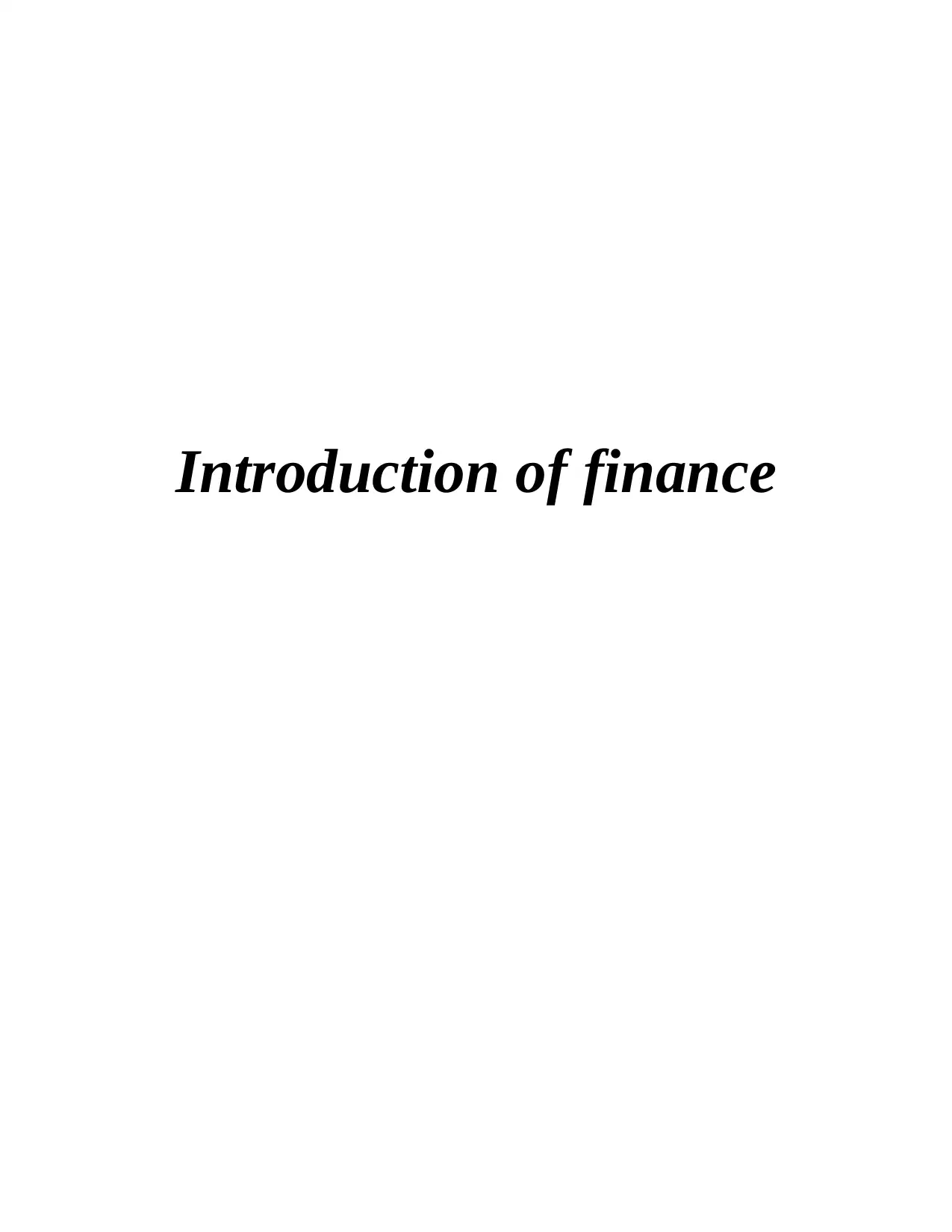
Introduction of finance
Paraphrase This Document
Need a fresh take? Get an instant paraphrase of this document with our AI Paraphraser
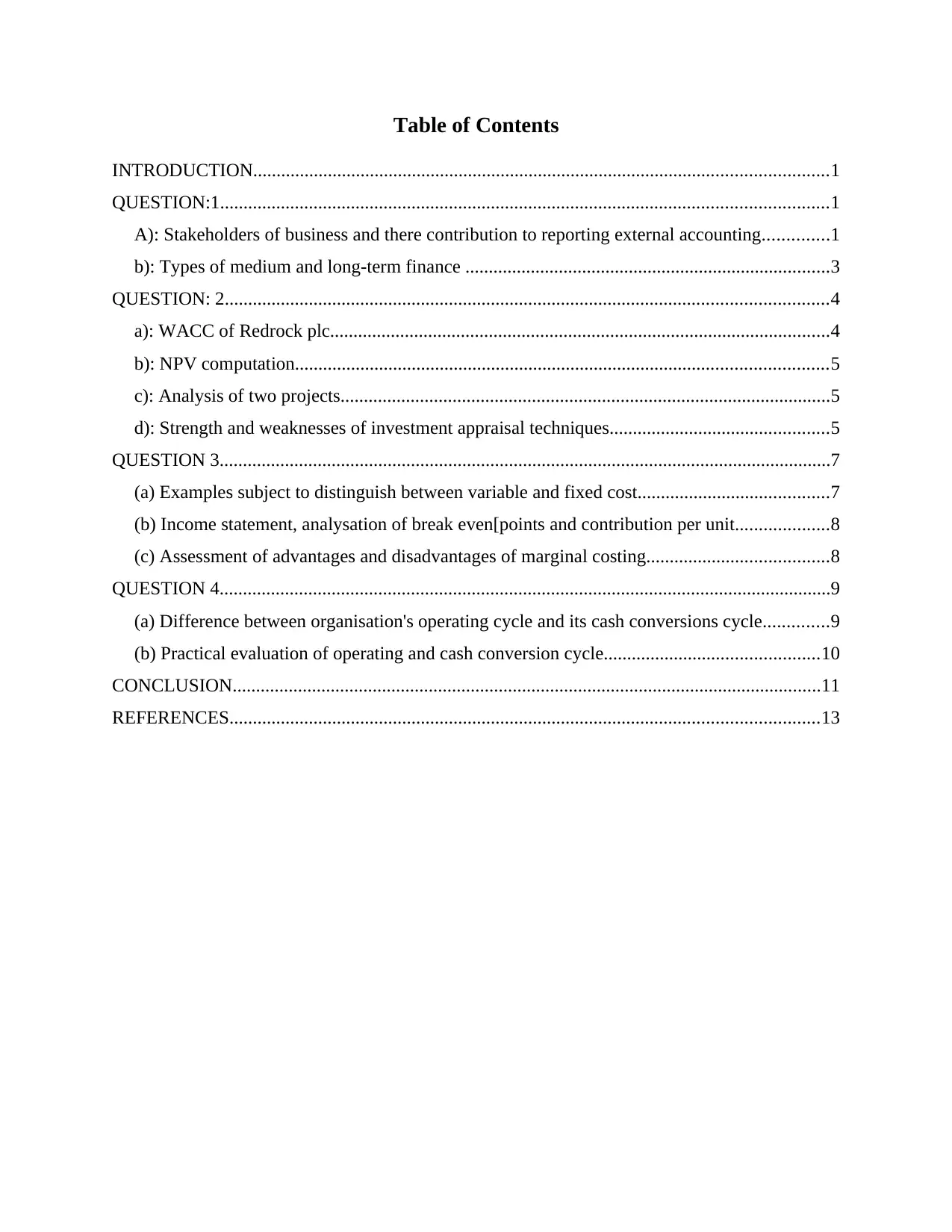
Table of Contents
INTRODUCTION...........................................................................................................................1
QUESTION:1..................................................................................................................................1
A): Stakeholders of business and there contribution to reporting external accounting..............1
b): Types of medium and long-term finance ..............................................................................3
QUESTION: 2.................................................................................................................................4
a): WACC of Redrock plc...........................................................................................................4
b): NPV computation..................................................................................................................5
c): Analysis of two projects.........................................................................................................5
d): Strength and weaknesses of investment appraisal techniques...............................................5
QUESTION 3...................................................................................................................................7
(a) Examples subject to distinguish between variable and fixed cost.........................................7
(b) Income statement, analysation of break even[points and contribution per unit....................8
(c) Assessment of advantages and disadvantages of marginal costing.......................................8
QUESTION 4...................................................................................................................................9
(a) Difference between organisation's operating cycle and its cash conversions cycle..............9
(b) Practical evaluation of operating and cash conversion cycle..............................................10
CONCLUSION..............................................................................................................................11
REFERENCES..............................................................................................................................13
INTRODUCTION...........................................................................................................................1
QUESTION:1..................................................................................................................................1
A): Stakeholders of business and there contribution to reporting external accounting..............1
b): Types of medium and long-term finance ..............................................................................3
QUESTION: 2.................................................................................................................................4
a): WACC of Redrock plc...........................................................................................................4
b): NPV computation..................................................................................................................5
c): Analysis of two projects.........................................................................................................5
d): Strength and weaknesses of investment appraisal techniques...............................................5
QUESTION 3...................................................................................................................................7
(a) Examples subject to distinguish between variable and fixed cost.........................................7
(b) Income statement, analysation of break even[points and contribution per unit....................8
(c) Assessment of advantages and disadvantages of marginal costing.......................................8
QUESTION 4...................................................................................................................................9
(a) Difference between organisation's operating cycle and its cash conversions cycle..............9
(b) Practical evaluation of operating and cash conversion cycle..............................................10
CONCLUSION..............................................................................................................................11
REFERENCES..............................................................................................................................13

⊘ This is a preview!⊘
Do you want full access?
Subscribe today to unlock all pages.

Trusted by 1+ million students worldwide
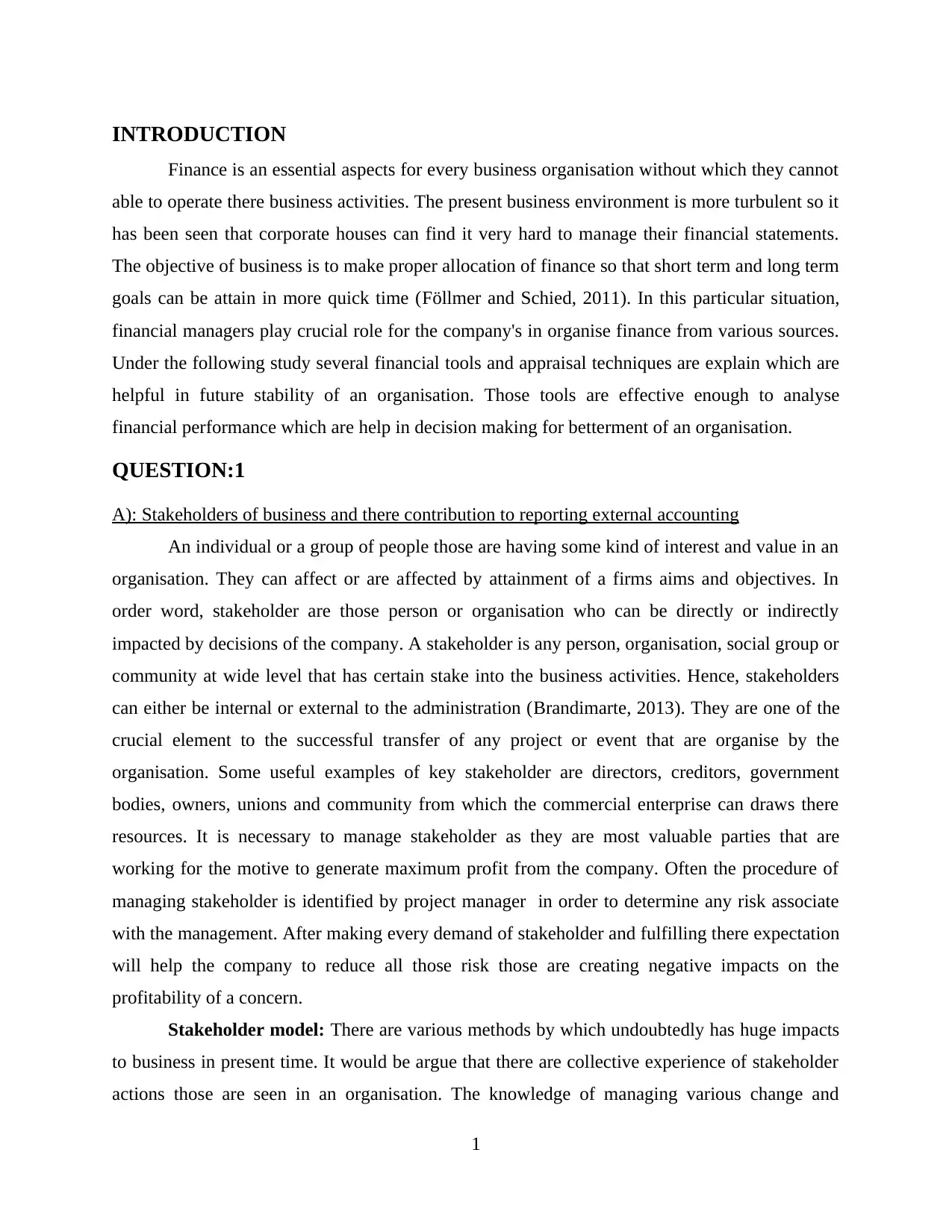
INTRODUCTION
Finance is an essential aspects for every business organisation without which they cannot
able to operate there business activities. The present business environment is more turbulent so it
has been seen that corporate houses can find it very hard to manage their financial statements.
The objective of business is to make proper allocation of finance so that short term and long term
goals can be attain in more quick time (Föllmer and Schied, 2011). In this particular situation,
financial managers play crucial role for the company's in organise finance from various sources.
Under the following study several financial tools and appraisal techniques are explain which are
helpful in future stability of an organisation. Those tools are effective enough to analyse
financial performance which are help in decision making for betterment of an organisation.
QUESTION:1
A): Stakeholders of business and there contribution to reporting external accounting
An individual or a group of people those are having some kind of interest and value in an
organisation. They can affect or are affected by attainment of a firms aims and objectives. In
order word, stakeholder are those person or organisation who can be directly or indirectly
impacted by decisions of the company. A stakeholder is any person, organisation, social group or
community at wide level that has certain stake into the business activities. Hence, stakeholders
can either be internal or external to the administration (Brandimarte, 2013). They are one of the
crucial element to the successful transfer of any project or event that are organise by the
organisation. Some useful examples of key stakeholder are directors, creditors, government
bodies, owners, unions and community from which the commercial enterprise can draws there
resources. It is necessary to manage stakeholder as they are most valuable parties that are
working for the motive to generate maximum profit from the company. Often the procedure of
managing stakeholder is identified by project manager in order to determine any risk associate
with the management. After making every demand of stakeholder and fulfilling there expectation
will help the company to reduce all those risk those are creating negative impacts on the
profitability of a concern.
Stakeholder model: There are various methods by which undoubtedly has huge impacts
to business in present time. It would be argue that there are collective experience of stakeholder
actions those are seen in an organisation. The knowledge of managing various change and
1
Finance is an essential aspects for every business organisation without which they cannot
able to operate there business activities. The present business environment is more turbulent so it
has been seen that corporate houses can find it very hard to manage their financial statements.
The objective of business is to make proper allocation of finance so that short term and long term
goals can be attain in more quick time (Föllmer and Schied, 2011). In this particular situation,
financial managers play crucial role for the company's in organise finance from various sources.
Under the following study several financial tools and appraisal techniques are explain which are
helpful in future stability of an organisation. Those tools are effective enough to analyse
financial performance which are help in decision making for betterment of an organisation.
QUESTION:1
A): Stakeholders of business and there contribution to reporting external accounting
An individual or a group of people those are having some kind of interest and value in an
organisation. They can affect or are affected by attainment of a firms aims and objectives. In
order word, stakeholder are those person or organisation who can be directly or indirectly
impacted by decisions of the company. A stakeholder is any person, organisation, social group or
community at wide level that has certain stake into the business activities. Hence, stakeholders
can either be internal or external to the administration (Brandimarte, 2013). They are one of the
crucial element to the successful transfer of any project or event that are organise by the
organisation. Some useful examples of key stakeholder are directors, creditors, government
bodies, owners, unions and community from which the commercial enterprise can draws there
resources. It is necessary to manage stakeholder as they are most valuable parties that are
working for the motive to generate maximum profit from the company. Often the procedure of
managing stakeholder is identified by project manager in order to determine any risk associate
with the management. After making every demand of stakeholder and fulfilling there expectation
will help the company to reduce all those risk those are creating negative impacts on the
profitability of a concern.
Stakeholder model: There are various methods by which undoubtedly has huge impacts
to business in present time. It would be argue that there are collective experience of stakeholder
actions those are seen in an organisation. The knowledge of managing various change and
1
Paraphrase This Document
Need a fresh take? Get an instant paraphrase of this document with our AI Paraphraser
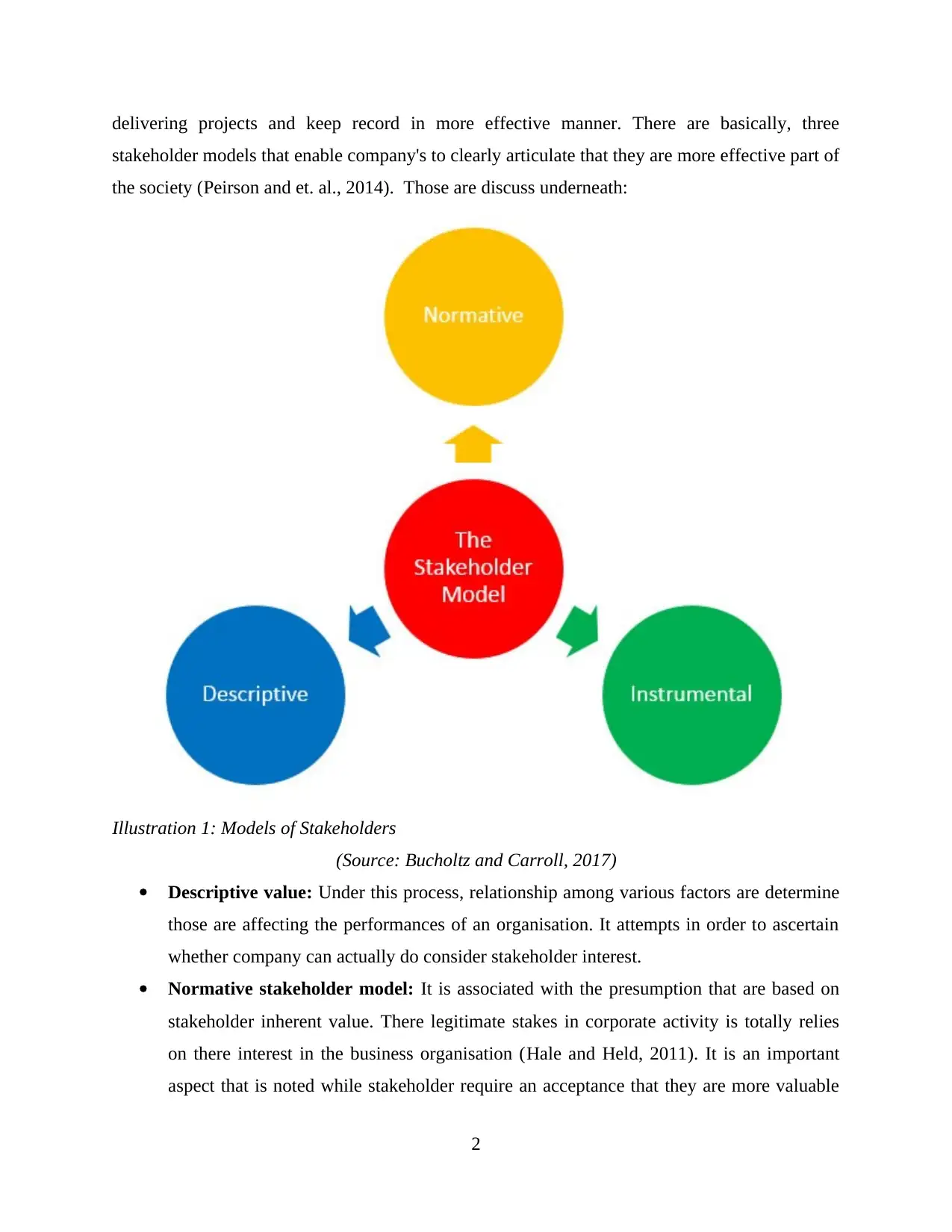
delivering projects and keep record in more effective manner. There are basically, three
stakeholder models that enable company's to clearly articulate that they are more effective part of
the society (Peirson and et. al., 2014). Those are discuss underneath:
Illustration 1: Models of Stakeholders
(Source: Bucholtz and Carroll, 2017)
Descriptive value: Under this process, relationship among various factors are determine
those are affecting the performances of an organisation. It attempts in order to ascertain
whether company can actually do consider stakeholder interest.
Normative stakeholder model: It is associated with the presumption that are based on
stakeholder inherent value. There legitimate stakes in corporate activity is totally relies
on there interest in the business organisation (Hale and Held, 2011). It is an important
aspect that is noted while stakeholder require an acceptance that they are more valuable
2
stakeholder models that enable company's to clearly articulate that they are more effective part of
the society (Peirson and et. al., 2014). Those are discuss underneath:
Illustration 1: Models of Stakeholders
(Source: Bucholtz and Carroll, 2017)
Descriptive value: Under this process, relationship among various factors are determine
those are affecting the performances of an organisation. It attempts in order to ascertain
whether company can actually do consider stakeholder interest.
Normative stakeholder model: It is associated with the presumption that are based on
stakeholder inherent value. There legitimate stakes in corporate activity is totally relies
on there interest in the business organisation (Hale and Held, 2011). It is an important
aspect that is noted while stakeholder require an acceptance that they are more valuable
2
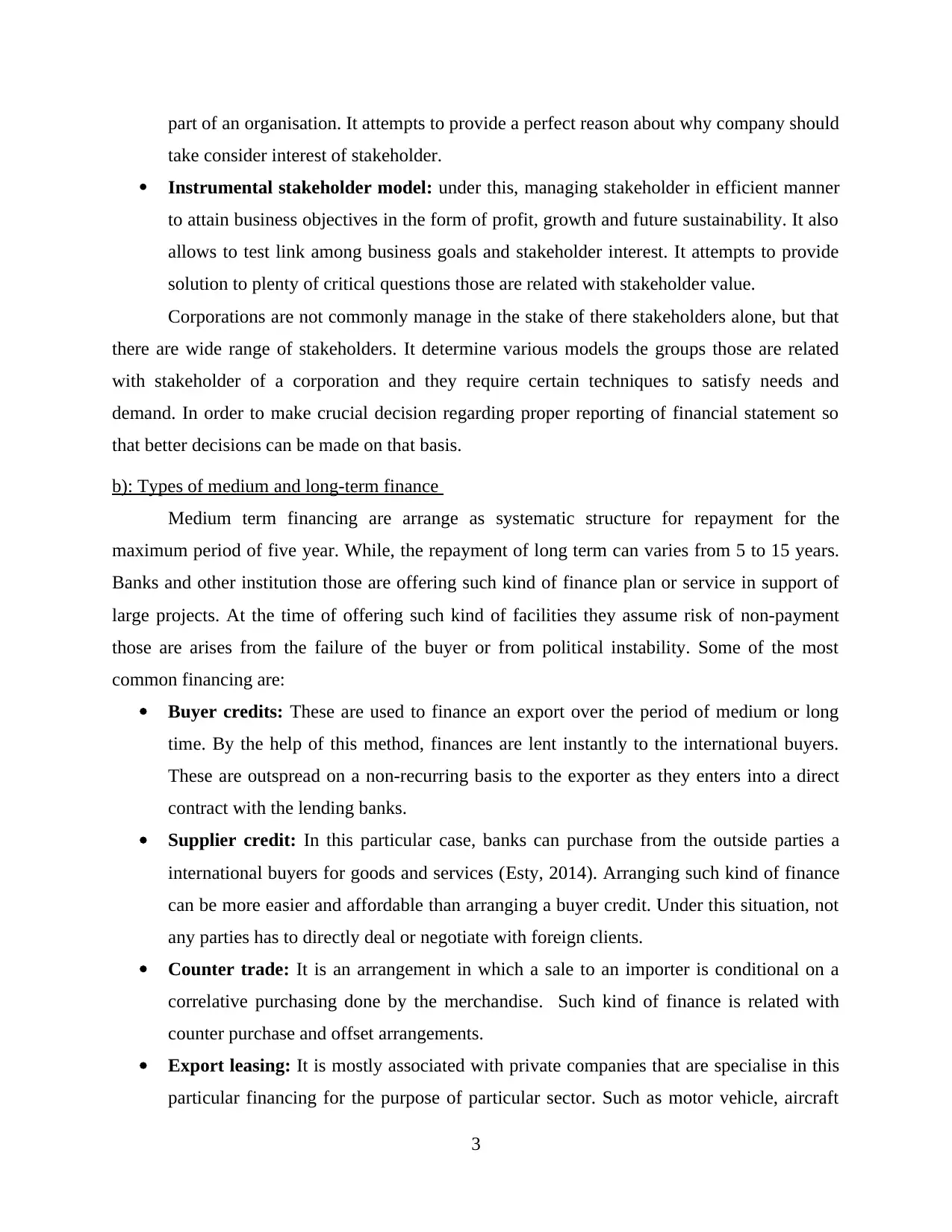
part of an organisation. It attempts to provide a perfect reason about why company should
take consider interest of stakeholder.
Instrumental stakeholder model: under this, managing stakeholder in efficient manner
to attain business objectives in the form of profit, growth and future sustainability. It also
allows to test link among business goals and stakeholder interest. It attempts to provide
solution to plenty of critical questions those are related with stakeholder value.
Corporations are not commonly manage in the stake of there stakeholders alone, but that
there are wide range of stakeholders. It determine various models the groups those are related
with stakeholder of a corporation and they require certain techniques to satisfy needs and
demand. In order to make crucial decision regarding proper reporting of financial statement so
that better decisions can be made on that basis.
b): Types of medium and long-term finance
Medium term financing are arrange as systematic structure for repayment for the
maximum period of five year. While, the repayment of long term can varies from 5 to 15 years.
Banks and other institution those are offering such kind of finance plan or service in support of
large projects. At the time of offering such kind of facilities they assume risk of non-payment
those are arises from the failure of the buyer or from political instability. Some of the most
common financing are:
Buyer credits: These are used to finance an export over the period of medium or long
time. By the help of this method, finances are lent instantly to the international buyers.
These are outspread on a non-recurring basis to the exporter as they enters into a direct
contract with the lending banks.
Supplier credit: In this particular case, banks can purchase from the outside parties a
international buyers for goods and services (Esty, 2014). Arranging such kind of finance
can be more easier and affordable than arranging a buyer credit. Under this situation, not
any parties has to directly deal or negotiate with foreign clients.
Counter trade: It is an arrangement in which a sale to an importer is conditional on a
correlative purchasing done by the merchandise. Such kind of finance is related with
counter purchase and offset arrangements.
Export leasing: It is mostly associated with private companies that are specialise in this
particular financing for the purpose of particular sector. Such as motor vehicle, aircraft
3
take consider interest of stakeholder.
Instrumental stakeholder model: under this, managing stakeholder in efficient manner
to attain business objectives in the form of profit, growth and future sustainability. It also
allows to test link among business goals and stakeholder interest. It attempts to provide
solution to plenty of critical questions those are related with stakeholder value.
Corporations are not commonly manage in the stake of there stakeholders alone, but that
there are wide range of stakeholders. It determine various models the groups those are related
with stakeholder of a corporation and they require certain techniques to satisfy needs and
demand. In order to make crucial decision regarding proper reporting of financial statement so
that better decisions can be made on that basis.
b): Types of medium and long-term finance
Medium term financing are arrange as systematic structure for repayment for the
maximum period of five year. While, the repayment of long term can varies from 5 to 15 years.
Banks and other institution those are offering such kind of finance plan or service in support of
large projects. At the time of offering such kind of facilities they assume risk of non-payment
those are arises from the failure of the buyer or from political instability. Some of the most
common financing are:
Buyer credits: These are used to finance an export over the period of medium or long
time. By the help of this method, finances are lent instantly to the international buyers.
These are outspread on a non-recurring basis to the exporter as they enters into a direct
contract with the lending banks.
Supplier credit: In this particular case, banks can purchase from the outside parties a
international buyers for goods and services (Esty, 2014). Arranging such kind of finance
can be more easier and affordable than arranging a buyer credit. Under this situation, not
any parties has to directly deal or negotiate with foreign clients.
Counter trade: It is an arrangement in which a sale to an importer is conditional on a
correlative purchasing done by the merchandise. Such kind of finance is related with
counter purchase and offset arrangements.
Export leasing: It is mostly associated with private companies that are specialise in this
particular financing for the purpose of particular sector. Such as motor vehicle, aircraft
3
⊘ This is a preview!⊘
Do you want full access?
Subscribe today to unlock all pages.

Trusted by 1+ million students worldwide
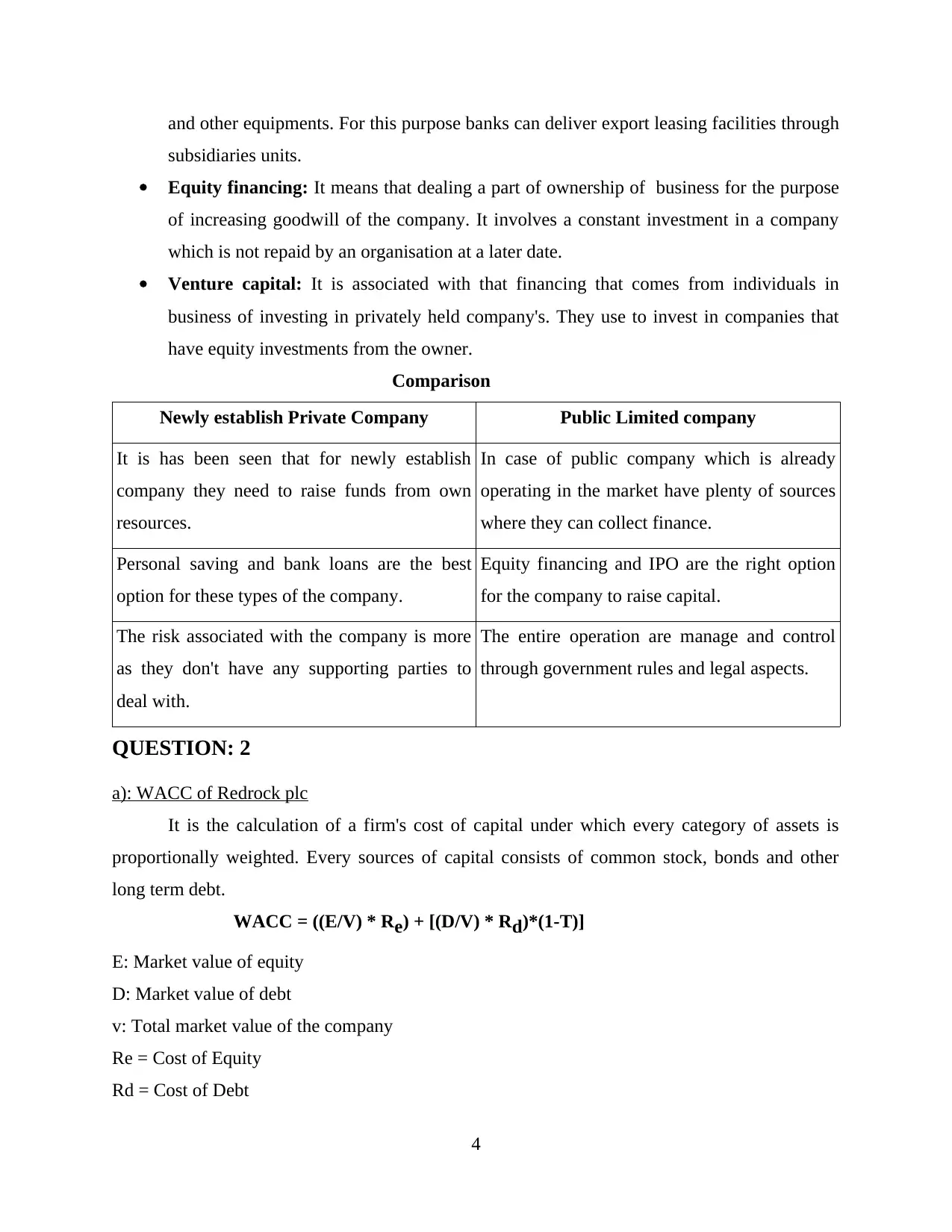
and other equipments. For this purpose banks can deliver export leasing facilities through
subsidiaries units.
Equity financing: It means that dealing a part of ownership of business for the purpose
of increasing goodwill of the company. It involves a constant investment in a company
which is not repaid by an organisation at a later date.
Venture capital: It is associated with that financing that comes from individuals in
business of investing in privately held company's. They use to invest in companies that
have equity investments from the owner.
Comparison
Newly establish Private Company Public Limited company
It is has been seen that for newly establish
company they need to raise funds from own
resources.
In case of public company which is already
operating in the market have plenty of sources
where they can collect finance.
Personal saving and bank loans are the best
option for these types of the company.
Equity financing and IPO are the right option
for the company to raise capital.
The risk associated with the company is more
as they don't have any supporting parties to
deal with.
The entire operation are manage and control
through government rules and legal aspects.
QUESTION: 2
a): WACC of Redrock plc
It is the calculation of a firm's cost of capital under which every category of assets is
proportionally weighted. Every sources of capital consists of common stock, bonds and other
long term debt.
WACC = ((E/V) * Re) + [(D/V) * Rd)*(1-T)]
E: Market value of equity
D: Market value of debt
v: Total market value of the company
Re = Cost of Equity
Rd = Cost of Debt
4
subsidiaries units.
Equity financing: It means that dealing a part of ownership of business for the purpose
of increasing goodwill of the company. It involves a constant investment in a company
which is not repaid by an organisation at a later date.
Venture capital: It is associated with that financing that comes from individuals in
business of investing in privately held company's. They use to invest in companies that
have equity investments from the owner.
Comparison
Newly establish Private Company Public Limited company
It is has been seen that for newly establish
company they need to raise funds from own
resources.
In case of public company which is already
operating in the market have plenty of sources
where they can collect finance.
Personal saving and bank loans are the best
option for these types of the company.
Equity financing and IPO are the right option
for the company to raise capital.
The risk associated with the company is more
as they don't have any supporting parties to
deal with.
The entire operation are manage and control
through government rules and legal aspects.
QUESTION: 2
a): WACC of Redrock plc
It is the calculation of a firm's cost of capital under which every category of assets is
proportionally weighted. Every sources of capital consists of common stock, bonds and other
long term debt.
WACC = ((E/V) * Re) + [(D/V) * Rd)*(1-T)]
E: Market value of equity
D: Market value of debt
v: Total market value of the company
Re = Cost of Equity
Rd = Cost of Debt
4
Paraphrase This Document
Need a fresh take? Get an instant paraphrase of this document with our AI Paraphraser
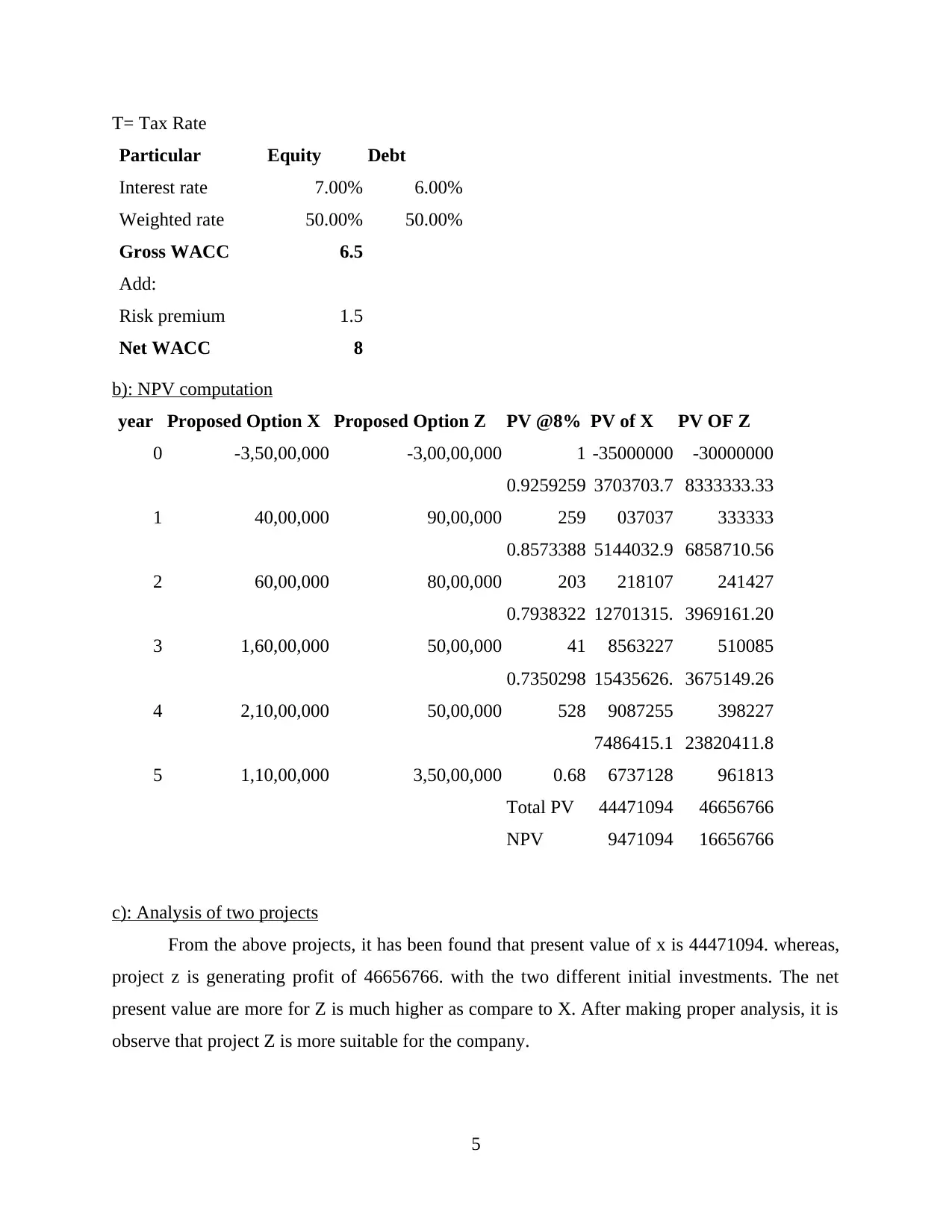
T= Tax Rate
Particular Equity Debt
Interest rate 7.00% 6.00%
Weighted rate 50.00% 50.00%
Gross WACC 6.5
Add:
Risk premium 1.5
Net WACC 8
b): NPV computation
year Proposed Option X Proposed Option Z PV @8% PV of X PV OF Z
0 -3,50,00,000 -3,00,00,000 1 -35000000 -30000000
1 40,00,000 90,00,000
0.9259259
259
3703703.7
037037
8333333.33
333333
2 60,00,000 80,00,000
0.8573388
203
5144032.9
218107
6858710.56
241427
3 1,60,00,000 50,00,000
0.7938322
41
12701315.
8563227
3969161.20
510085
4 2,10,00,000 50,00,000
0.7350298
528
15435626.
9087255
3675149.26
398227
5 1,10,00,000 3,50,00,000 0.68
7486415.1
6737128
23820411.8
961813
Total PV 44471094 46656766
NPV 9471094 16656766
c): Analysis of two projects
From the above projects, it has been found that present value of x is 44471094. whereas,
project z is generating profit of 46656766. with the two different initial investments. The net
present value are more for Z is much higher as compare to X. After making proper analysis, it is
observe that project Z is more suitable for the company.
5
Particular Equity Debt
Interest rate 7.00% 6.00%
Weighted rate 50.00% 50.00%
Gross WACC 6.5
Add:
Risk premium 1.5
Net WACC 8
b): NPV computation
year Proposed Option X Proposed Option Z PV @8% PV of X PV OF Z
0 -3,50,00,000 -3,00,00,000 1 -35000000 -30000000
1 40,00,000 90,00,000
0.9259259
259
3703703.7
037037
8333333.33
333333
2 60,00,000 80,00,000
0.8573388
203
5144032.9
218107
6858710.56
241427
3 1,60,00,000 50,00,000
0.7938322
41
12701315.
8563227
3969161.20
510085
4 2,10,00,000 50,00,000
0.7350298
528
15435626.
9087255
3675149.26
398227
5 1,10,00,000 3,50,00,000 0.68
7486415.1
6737128
23820411.8
961813
Total PV 44471094 46656766
NPV 9471094 16656766
c): Analysis of two projects
From the above projects, it has been found that present value of x is 44471094. whereas,
project z is generating profit of 46656766. with the two different initial investments. The net
present value are more for Z is much higher as compare to X. After making proper analysis, it is
observe that project Z is more suitable for the company.
5
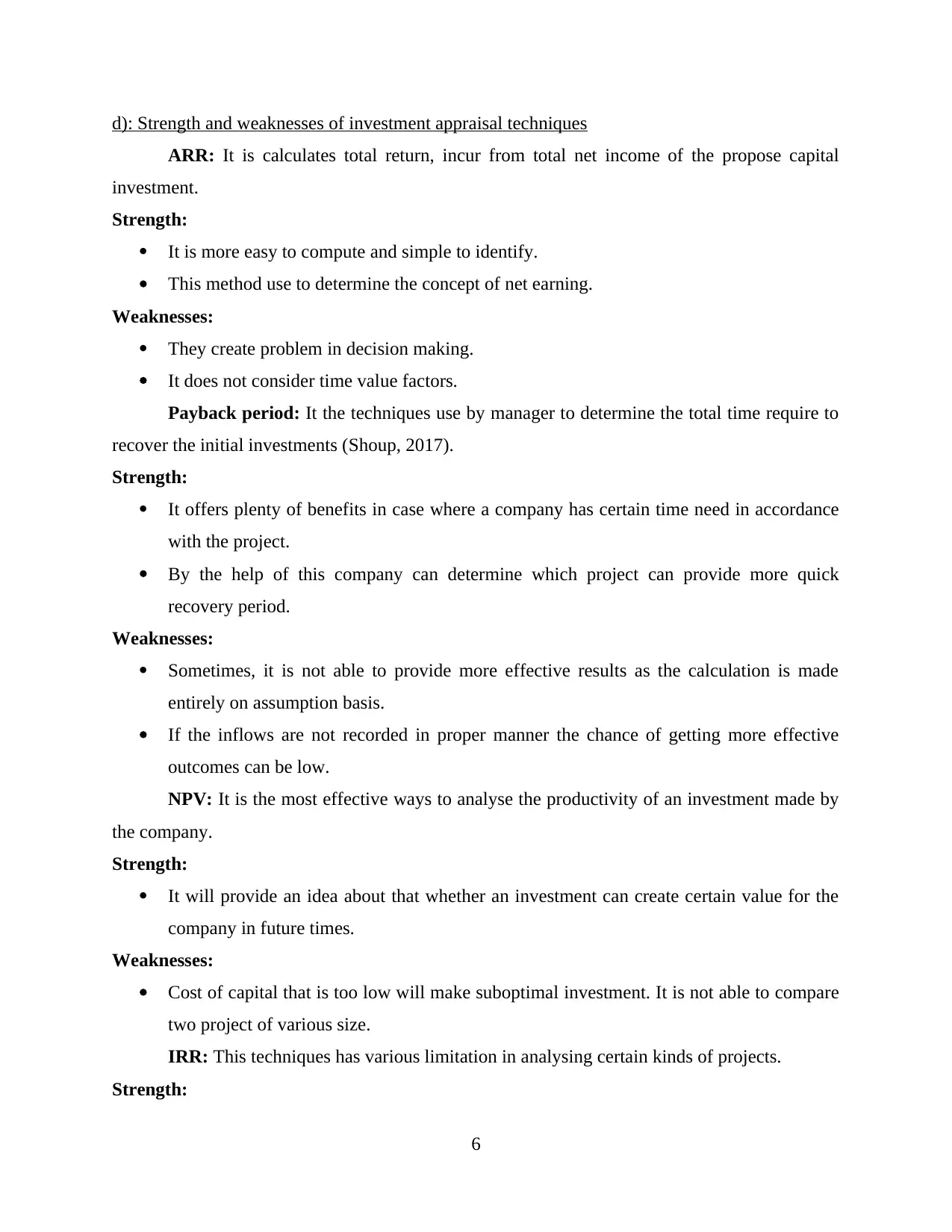
d): Strength and weaknesses of investment appraisal techniques
ARR: It is calculates total return, incur from total net income of the propose capital
investment.
Strength:
It is more easy to compute and simple to identify.
This method use to determine the concept of net earning.
Weaknesses:
They create problem in decision making.
It does not consider time value factors.
Payback period: It the techniques use by manager to determine the total time require to
recover the initial investments (Shoup, 2017).
Strength:
It offers plenty of benefits in case where a company has certain time need in accordance
with the project.
By the help of this company can determine which project can provide more quick
recovery period.
Weaknesses:
Sometimes, it is not able to provide more effective results as the calculation is made
entirely on assumption basis.
If the inflows are not recorded in proper manner the chance of getting more effective
outcomes can be low.
NPV: It is the most effective ways to analyse the productivity of an investment made by
the company.
Strength:
It will provide an idea about that whether an investment can create certain value for the
company in future times.
Weaknesses:
Cost of capital that is too low will make suboptimal investment. It is not able to compare
two project of various size.
IRR: This techniques has various limitation in analysing certain kinds of projects.
Strength:
6
ARR: It is calculates total return, incur from total net income of the propose capital
investment.
Strength:
It is more easy to compute and simple to identify.
This method use to determine the concept of net earning.
Weaknesses:
They create problem in decision making.
It does not consider time value factors.
Payback period: It the techniques use by manager to determine the total time require to
recover the initial investments (Shoup, 2017).
Strength:
It offers plenty of benefits in case where a company has certain time need in accordance
with the project.
By the help of this company can determine which project can provide more quick
recovery period.
Weaknesses:
Sometimes, it is not able to provide more effective results as the calculation is made
entirely on assumption basis.
If the inflows are not recorded in proper manner the chance of getting more effective
outcomes can be low.
NPV: It is the most effective ways to analyse the productivity of an investment made by
the company.
Strength:
It will provide an idea about that whether an investment can create certain value for the
company in future times.
Weaknesses:
Cost of capital that is too low will make suboptimal investment. It is not able to compare
two project of various size.
IRR: This techniques has various limitation in analysing certain kinds of projects.
Strength:
6
⊘ This is a preview!⊘
Do you want full access?
Subscribe today to unlock all pages.

Trusted by 1+ million students worldwide
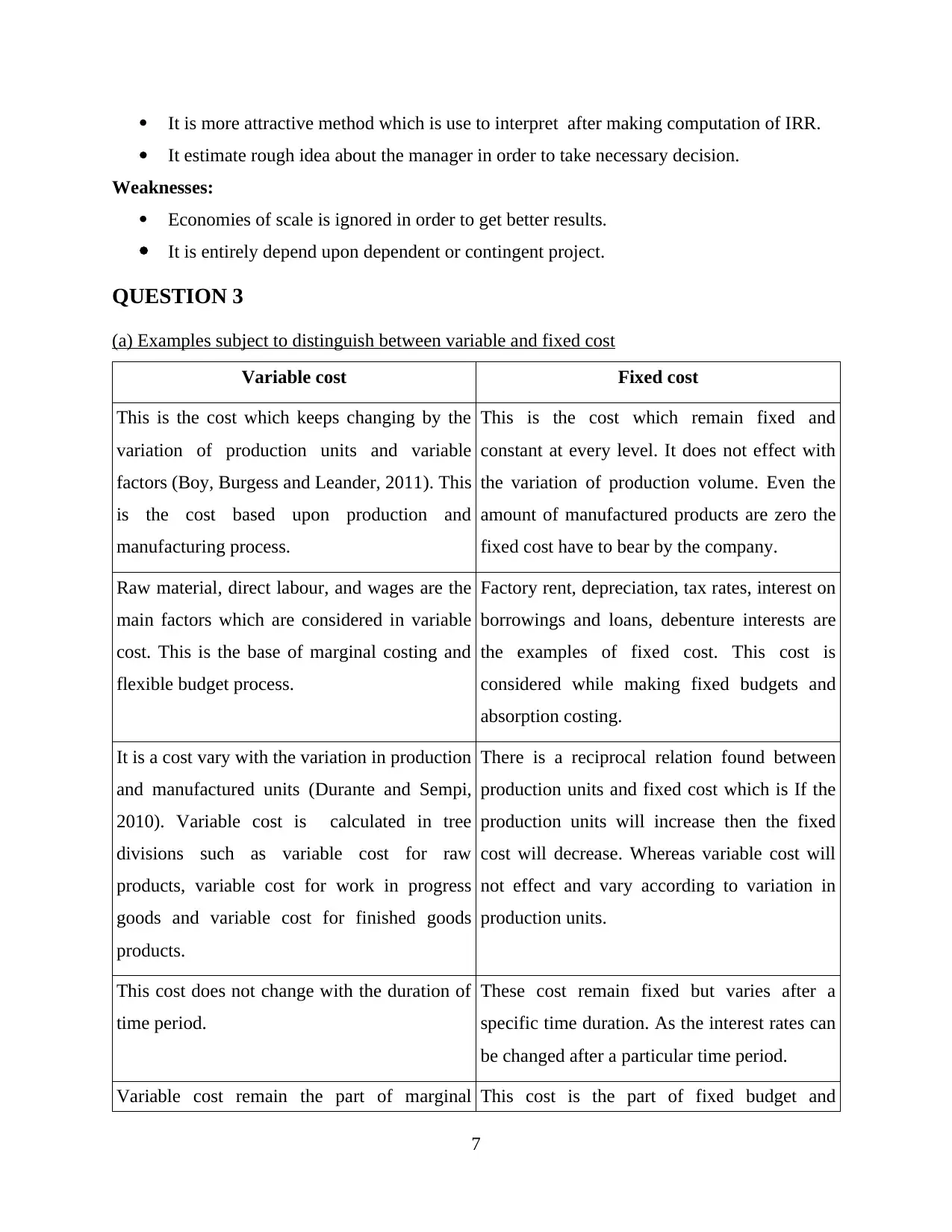
It is more attractive method which is use to interpret after making computation of IRR.
It estimate rough idea about the manager in order to take necessary decision.
Weaknesses:
Economies of scale is ignored in order to get better results.
It is entirely depend upon dependent or contingent project.
QUESTION 3
(a) Examples subject to distinguish between variable and fixed cost
Variable cost Fixed cost
This is the cost which keeps changing by the
variation of production units and variable
factors (Boy, Burgess and Leander, 2011). This
is the cost based upon production and
manufacturing process.
This is the cost which remain fixed and
constant at every level. It does not effect with
the variation of production volume. Even the
amount of manufactured products are zero the
fixed cost have to bear by the company.
Raw material, direct labour, and wages are the
main factors which are considered in variable
cost. This is the base of marginal costing and
flexible budget process.
Factory rent, depreciation, tax rates, interest on
borrowings and loans, debenture interests are
the examples of fixed cost. This cost is
considered while making fixed budgets and
absorption costing.
It is a cost vary with the variation in production
and manufactured units (Durante and Sempi,
2010). Variable cost is calculated in tree
divisions such as variable cost for raw
products, variable cost for work in progress
goods and variable cost for finished goods
products.
There is a reciprocal relation found between
production units and fixed cost which is If the
production units will increase then the fixed
cost will decrease. Whereas variable cost will
not effect and vary according to variation in
production units.
This cost does not change with the duration of
time period.
These cost remain fixed but varies after a
specific time duration. As the interest rates can
be changed after a particular time period.
Variable cost remain the part of marginal This cost is the part of fixed budget and
7
It estimate rough idea about the manager in order to take necessary decision.
Weaknesses:
Economies of scale is ignored in order to get better results.
It is entirely depend upon dependent or contingent project.
QUESTION 3
(a) Examples subject to distinguish between variable and fixed cost
Variable cost Fixed cost
This is the cost which keeps changing by the
variation of production units and variable
factors (Boy, Burgess and Leander, 2011). This
is the cost based upon production and
manufacturing process.
This is the cost which remain fixed and
constant at every level. It does not effect with
the variation of production volume. Even the
amount of manufactured products are zero the
fixed cost have to bear by the company.
Raw material, direct labour, and wages are the
main factors which are considered in variable
cost. This is the base of marginal costing and
flexible budget process.
Factory rent, depreciation, tax rates, interest on
borrowings and loans, debenture interests are
the examples of fixed cost. This cost is
considered while making fixed budgets and
absorption costing.
It is a cost vary with the variation in production
and manufactured units (Durante and Sempi,
2010). Variable cost is calculated in tree
divisions such as variable cost for raw
products, variable cost for work in progress
goods and variable cost for finished goods
products.
There is a reciprocal relation found between
production units and fixed cost which is If the
production units will increase then the fixed
cost will decrease. Whereas variable cost will
not effect and vary according to variation in
production units.
This cost does not change with the duration of
time period.
These cost remain fixed but varies after a
specific time duration. As the interest rates can
be changed after a particular time period.
Variable cost remain the part of marginal This cost is the part of fixed budget and
7
Paraphrase This Document
Need a fresh take? Get an instant paraphrase of this document with our AI Paraphraser
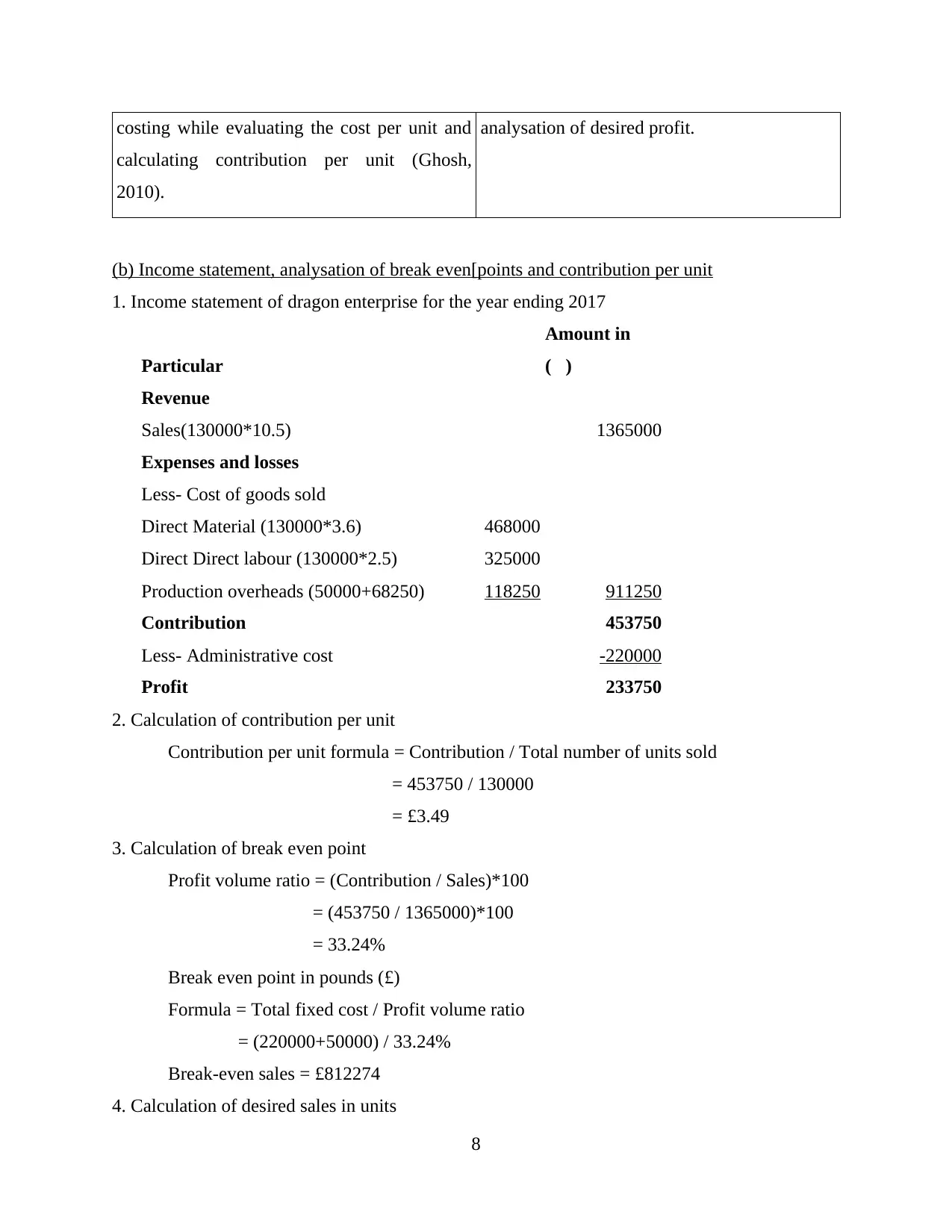
costing while evaluating the cost per unit and
calculating contribution per unit (Ghosh,
2010).
analysation of desired profit.
(b) Income statement, analysation of break even[points and contribution per unit
1. Income statement of dragon enterprise for the year ending 2017
Particular
Amount in
(£)
Revenue
Sales(130000*10.5) 1365000
Expenses and losses
Less- Cost of goods sold
Direct Material (130000*3.6) 468000
Direct Direct labour (130000*2.5) 325000
Production overheads (50000+68250) 118250 911250
Contribution 453750
Less- Administrative cost -220000
Profit 233750
2. Calculation of contribution per unit
Contribution per unit formula = Contribution / Total number of units sold
= 453750 / 130000
= £3.49
3. Calculation of break even point
Profit volume ratio = (Contribution / Sales)*100
= (453750 / 1365000)*100
= 33.24%
Break even point in pounds (£)
Formula = Total fixed cost / Profit volume ratio
= (220000+50000) / 33.24%
Break-even sales = £812274
4. Calculation of desired sales in units
8
calculating contribution per unit (Ghosh,
2010).
analysation of desired profit.
(b) Income statement, analysation of break even[points and contribution per unit
1. Income statement of dragon enterprise for the year ending 2017
Particular
Amount in
(£)
Revenue
Sales(130000*10.5) 1365000
Expenses and losses
Less- Cost of goods sold
Direct Material (130000*3.6) 468000
Direct Direct labour (130000*2.5) 325000
Production overheads (50000+68250) 118250 911250
Contribution 453750
Less- Administrative cost -220000
Profit 233750
2. Calculation of contribution per unit
Contribution per unit formula = Contribution / Total number of units sold
= 453750 / 130000
= £3.49
3. Calculation of break even point
Profit volume ratio = (Contribution / Sales)*100
= (453750 / 1365000)*100
= 33.24%
Break even point in pounds (£)
Formula = Total fixed cost / Profit volume ratio
= (220000+50000) / 33.24%
Break-even sales = £812274
4. Calculation of desired sales in units
8
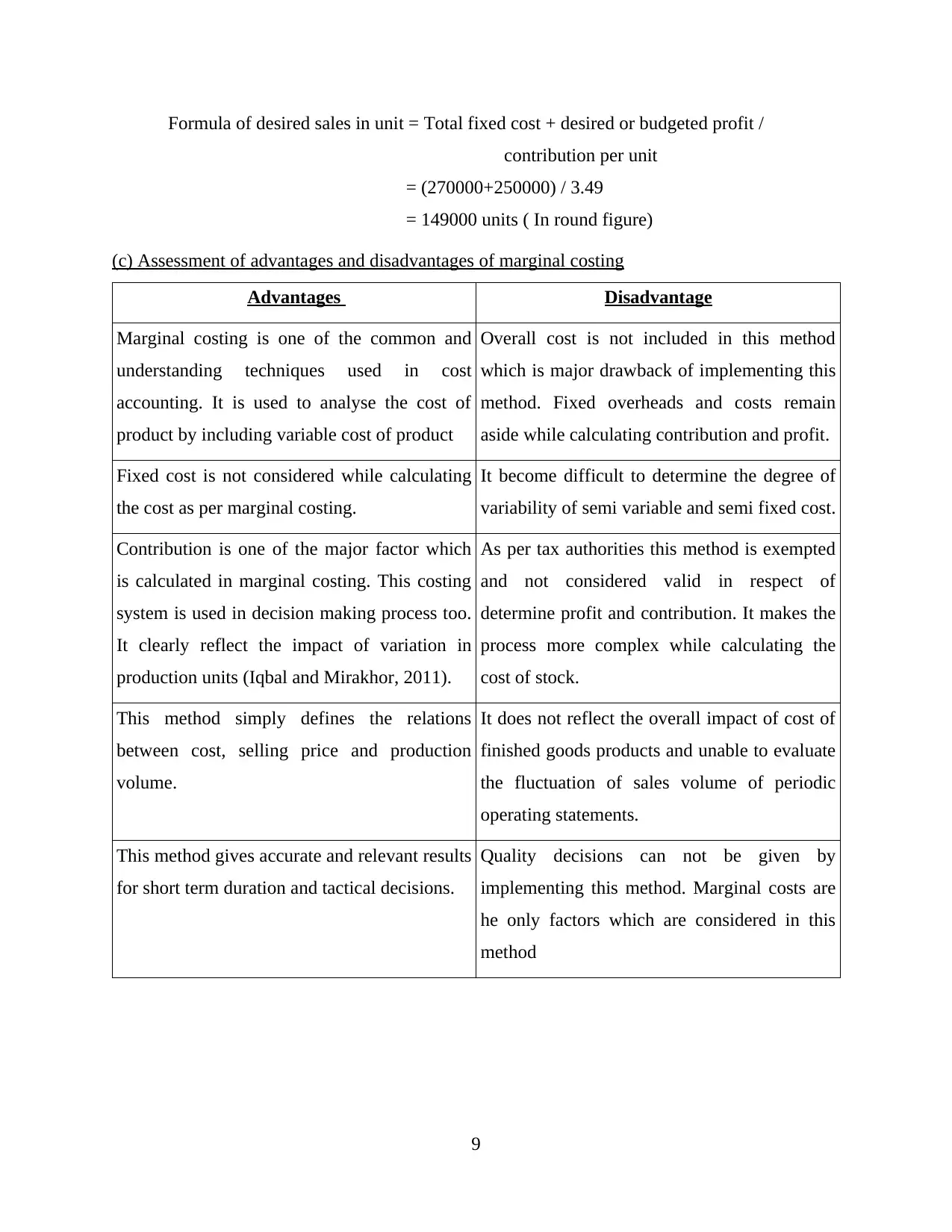
Formula of desired sales in unit = Total fixed cost + desired or budgeted profit /
contribution per unit
= (270000+250000) / 3.49
= 149000 units ( In round figure)
(c) Assessment of advantages and disadvantages of marginal costing
Advantages Disadvantage
Marginal costing is one of the common and
understanding techniques used in cost
accounting. It is used to analyse the cost of
product by including variable cost of product
Overall cost is not included in this method
which is major drawback of implementing this
method. Fixed overheads and costs remain
aside while calculating contribution and profit.
Fixed cost is not considered while calculating
the cost as per marginal costing.
It become difficult to determine the degree of
variability of semi variable and semi fixed cost.
Contribution is one of the major factor which
is calculated in marginal costing. This costing
system is used in decision making process too.
It clearly reflect the impact of variation in
production units (Iqbal and Mirakhor, 2011).
As per tax authorities this method is exempted
and not considered valid in respect of
determine profit and contribution. It makes the
process more complex while calculating the
cost of stock.
This method simply defines the relations
between cost, selling price and production
volume.
It does not reflect the overall impact of cost of
finished goods products and unable to evaluate
the fluctuation of sales volume of periodic
operating statements.
This method gives accurate and relevant results
for short term duration and tactical decisions.
Quality decisions can not be given by
implementing this method. Marginal costs are
he only factors which are considered in this
method
9
contribution per unit
= (270000+250000) / 3.49
= 149000 units ( In round figure)
(c) Assessment of advantages and disadvantages of marginal costing
Advantages Disadvantage
Marginal costing is one of the common and
understanding techniques used in cost
accounting. It is used to analyse the cost of
product by including variable cost of product
Overall cost is not included in this method
which is major drawback of implementing this
method. Fixed overheads and costs remain
aside while calculating contribution and profit.
Fixed cost is not considered while calculating
the cost as per marginal costing.
It become difficult to determine the degree of
variability of semi variable and semi fixed cost.
Contribution is one of the major factor which
is calculated in marginal costing. This costing
system is used in decision making process too.
It clearly reflect the impact of variation in
production units (Iqbal and Mirakhor, 2011).
As per tax authorities this method is exempted
and not considered valid in respect of
determine profit and contribution. It makes the
process more complex while calculating the
cost of stock.
This method simply defines the relations
between cost, selling price and production
volume.
It does not reflect the overall impact of cost of
finished goods products and unable to evaluate
the fluctuation of sales volume of periodic
operating statements.
This method gives accurate and relevant results
for short term duration and tactical decisions.
Quality decisions can not be given by
implementing this method. Marginal costs are
he only factors which are considered in this
method
9
⊘ This is a preview!⊘
Do you want full access?
Subscribe today to unlock all pages.

Trusted by 1+ million students worldwide
1 out of 17
Related Documents
Your All-in-One AI-Powered Toolkit for Academic Success.
+13062052269
info@desklib.com
Available 24*7 on WhatsApp / Email
![[object Object]](/_next/static/media/star-bottom.7253800d.svg)
Unlock your academic potential
Copyright © 2020–2025 A2Z Services. All Rights Reserved. Developed and managed by ZUCOL.




